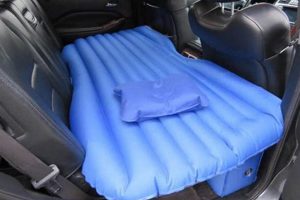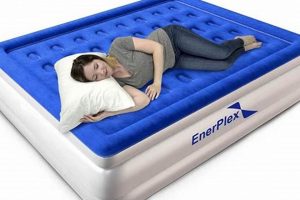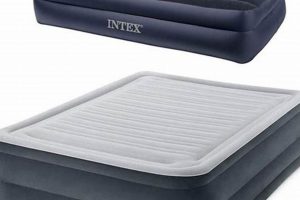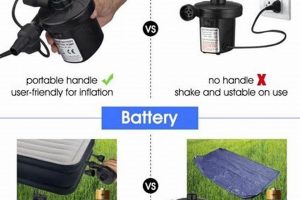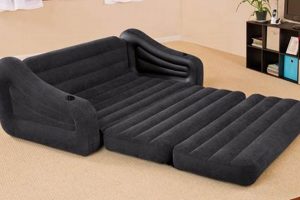Locating the source of leakage in inflatable mattresses is essential for maintaining their usability and comfort. This process involves a systematic approach to identify areas where air escapes, ultimately leading to deflation. The methodologies employed range from simple auditory and tactile inspections to more involved techniques utilizing soapy water or specialized detection equipment.
The ability to identify and subsequently repair punctures or tears in these mattresses offers several advantages. It extends the lifespan of the product, reducing the need for frequent replacements and minimizing waste. Furthermore, addressing leaks promptly ensures consistent support and a comfortable sleep surface, preventing disruptions and potential discomfort during use. Historically, identifying these leaks relied heavily on intuition and rudimentary methods; modern techniques offer greater precision and efficiency.
Therefore, a detailed examination of effective leak detection strategies is warranted. This includes methods suitable for various environments and mattress materials, ensuring the longevity and optimal performance of inflatable mattresses.
Strategies for Leak Detection in Air Mattresses
Effective location of air leaks in inflatable mattresses requires a systematic approach. The following tips outline methods for identifying punctures and tears.
Tip 1: Auditory Inspection: Quiet the surroundings and listen carefully for hissing sounds emanating from the mattress. Pay particular attention to seams, valves, and areas that experience the most stress.
Tip 2: Tactile Examination: Slowly run a hand over the surface of the inflated mattress, focusing on areas where air movement can be felt. Subtle drafts may indicate the presence of a small leak.
Tip 3: Soapy Water Application: Mix mild dish soap with water and apply a thin layer to the mattress surface using a sponge or spray bottle. The formation of bubbles indicates the precise location of air escaping.
Tip 4: Submersion Technique: If practical, partially submerge the inflated mattress in a tub of water. Observe for streams of bubbles rising from the mattress, marking the point of leakage. (Only applicable for smaller air mattresses)
Tip 5: Pressure Sensitivity Test: Inflate the mattress to its maximum capacity and apply focused pressure to different sections. Increased air escaping sound while pressed indicating a higher likelihood of hole location.
Tip 6: Visual Inspection: A careful visual check can sometimes reveal small holes or tears, especially in areas that are stretched or worn. Look for discoloration or unusual textures on the mattress surface.
Tip 7: Light Source Enhancement: In a darkened room, shine a bright light behind the inflated mattress. Small holes may become more visible as light passes through them.
These methods facilitate the accurate location of air leaks, enabling prompt repair and extending the useful life of the inflatable mattress. Implementing these techniques avoids unnecessary replacement costs and maintains optimal mattress performance.
Following the identification of leak, appropriate repair procedures should be implemented. Patching or sealing the puncture promptly will restore the mattress to its intended functionality.
1. Auditory Detection
Auditory detection is a fundamental technique employed in locating leaks in inflatable mattresses. The premise is that escaping air produces an audible hissing sound, the intensity of which is related to the size and pressure of the leak. The effectiveness of auditory detection depends on the ambient noise level; quiet environments permit the easier identification of even minute air leaks. For instance, a small puncture along a mattress seam may produce a faint, high-pitched sound that is easily masked by household appliances or external traffic. Conversely, a larger tear will generate a more pronounced and readily detectable hissing sound.
The practical application of auditory detection involves systematically listening for air escaping from the mattress surface. The user should proceed slowly, bringing their ear close to the suspected areas while minimizing external noise interference. Specific attention should be paid to the seams, valve, and areas that experience frequent stress or bending, as these are more prone to developing leaks. This method’s non-invasive nature and simplicity make it the initial step in the leak detection process. However, reliance solely on auditory detection may not be sufficient for identifying very small or slow leaks, necessitating the use of complementary methods such as the soapy water test or tactile examination.
In conclusion, while auditory detection offers a straightforward initial approach to identifying leaks in inflatable mattresses, its success is heavily influenced by environmental conditions and the size of the leak. Therefore, auditory assessment acts most effectively as a preliminary diagnostic tool, guiding further, more precise leak detection methods. The understanding of the method limitations can save time by moving quickly to more concrete methods.
2. Tactile Sensitivity
Tactile sensitivity plays a crucial role in locating leaks in inflatable mattresses. This method relies on the human sense of touch to detect subtle air currents emanating from punctures or tears, offering a direct means of identifying the source of leakage.
- Detection of Minute Airflow
Tactile sensitivity allows for the detection of even minute airflow, which might be imperceptible through auditory means alone. By slowly moving a hand close to the surface of the inflated mattress, the user can perceive subtle drafts indicating escaping air. This is particularly useful for identifying pinhole leaks or slow leaks along seams.
- Amplification through Environmental Conditions
Environmental conditions can enhance the effectiveness of tactile sensitivity. A slight breeze or a cool room can amplify the sensation of escaping air, making it easier to detect. The user can deliberately create a gentle airflow to further enhance the tactile feedback from the leak.
- Subjective Variability
The effectiveness of tactile sensitivity is inherently subjective and varies depending on the individual’s sensitivity to airflow. Factors such as skin moisture, ambient temperature, and individual perception thresholds can influence the ability to detect leaks using this method. Consistent practice and focus can help improve the user’s tactile acuity.
- Complementary Technique
Tactile sensitivity often serves as a complementary technique alongside other leak detection methods. While it can provide a general indication of the le
ak’s location, it may not be precise enough for pinpointing the exact source. Combining tactile sensitivity with visual inspection or the soapy water test can significantly improve the accuracy of leak detection.
The application of tactile sensitivity, despite its subjective nature, represents a valuable initial step in the process of identifying leaks in inflatable mattresses. Its utility lies in its simplicity and accessibility, providing a quick and non-invasive means of detecting potential leak sources. However, it is most effective when integrated with other leak detection techniques to ensure accurate identification and subsequent repair.
3. Soapy Water Solution
The soapy water solution is a common and effective technique for locating leaks in inflatable mattresses. This method leverages the principle that escaping air, when forced through a thin film of soapy water, creates visible bubbles at the point of egress. The formation of these bubbles directly indicates the precise location of the leak, transforming an otherwise undetectable air current into a readily identifiable visual cue. This approach is predicated on the differential surface tension between the air escaping the mattress and the surrounding soapy water film.
The application of this method is straightforward. A mixture of mild dish soap and water is applied to the inflated mattress, typically using a sponge, spray bottle, or brush. Particular attention is paid to seams, valves, and areas known to experience stress or abrasion, as these are common locations for leaks to develop. As air escapes through a puncture or tear, it passes through the soapy water film, creating bubbles that grow in size and number, thus pinpointing the source of the leak. A practical example involves an air mattress used for camping, where small thorns or abrasive ground surfaces may cause pinhole leaks. Applying the soapy water solution in this scenario would quickly reveal these minute punctures.
In summary, the soapy water solution offers a reliable and cost-effective means of identifying leaks in inflatable mattresses. Its effectiveness stems from the visual amplification of escaping air, transforming a potentially challenging task into a simple and easily observable process. While other methods exist, the soapy water solution remains a staple in leak detection due to its accessibility and accuracy. The correct application of this method facilitates prompt repairs, preserving the functionality and extending the lifespan of the inflatable mattress.
4. Submersion Observation
Submersion observation represents a direct and often highly effective method for leak detection in inflatable mattresses. The technique involves immersing the inflated mattress, either partially or fully depending on its size, in water and observing for the emergence of air bubbles. The principle at play is that any escaping air, regardless of the size of the puncture, will displace the water and manifest as a stream of bubbles originating from the leak’s location. This visual indication provides a clear and unambiguous pinpoint of the source of the problem, which facilitates targeted repair efforts. This stands as a prominent method within strategies to address discovering holes or tears in air mattresses.
The utility of submersion observation lies in its capacity to reveal even minute leaks that may be difficult or impossible to detect using other methods, such as auditory or tactile examination. For example, a slow leak caused by a microscopic puncture can be virtually undetectable by ear; however, when submerged, even this subtle escape of air becomes visually apparent as a continuous stream of tiny bubbles. The success of this method is heavily dependent on the clarity of the water and the lighting conditions. Turbid water or poor illumination can obscure the bubbles, reducing the effectiveness of the observation. Smaller air mattresses can be fully submerged in bathtubs or large containers. Larger mattresses require a section-by-section immersion approach. The practical significance of this understanding lies in its ability to significantly reduce the time and effort required to identify and repair leaks, saving resources and extending the lifespan of the air mattress.
In conclusion, submersion observation provides a valuable tool in the arsenal for locating leaks in inflatable mattresses. While not always the most convenient method, particularly for large mattresses, its capacity to reveal even the smallest leaks makes it an indispensable technique. Challenges associated with water clarity and mattress size can be mitigated through careful planning and execution, ensuring that this method contributes effectively to the comprehensive process of leak detection and repair. Implementing strategies around careful submersion is an asset for ensuring proper function of an air mattress.
5. Visual Scrutiny
Visual scrutiny forms a critical component of the process of locating punctures or tears in inflatable mattresses. This method relies on a detailed examination of the mattress surface to identify physical anomalies indicative of potential leaks, offering a non-invasive initial step in the repair process.
- Surface Irregularities
Visual scrutiny involves a careful assessment of the mattress surface for any deviations from its normal appearance. These irregularities can manifest as small tears, abrasions, discolorations, or areas of unusual texture. For example, a small, dark spot may indicate a puncture caused by a sharp object. These subtle signs often precede complete deflation and can allow for early intervention.
- Seam Inspection
Mattress seams represent a common point of failure due to the concentrated stress they endure during inflation and use. Visual scrutiny of seams entails close examination for any signs of separation, fraying, or adhesive failure. Separated seams, even if small, can lead to significant air loss over time. These visual cues offer a preemptive opportunity to reinforce or repair the seam before complete failure occurs.
- Valve Assessment
The mattress valve is a critical component for inflation and deflation, and its integrity is paramount. Visual scrutiny of the valve involves assessing its physical condition for cracks, distortions, or improper sealing. A cracked valve body or a worn seal can result in a persistent leak, rendering the mattress unusable. This step necessitates close attention to ensure the valve’s secure attachment to the mattress and the absence of any visible damage.
- Environmental Contextualization
The environment in which the mattress is used can provide valuable context for visual scrutiny. For instance, if the mattress was used outdoors on rough terrain, the examiner should pay particular attention to the underside for signs of abrasion or puncture from rocks or debris. Understanding the use conditions allows for a more focused and effective visual inspection.
The effectiveness of visual scrutiny as a method for locating leaks in inflatable mattresses relies on careful observation and attention to detail. While this method may not always be sufficient for identifying
very small or slow leaks, it serves as an essential initial step that can significantly streamline the subsequent leak detection and repair process. The insights gained during visual scrutiny can guide the application of more specialized techniques, such as the soapy water test or submersion observation, leading to efficient resolution of the problem.
6. Pressure Point Testing
Pressure point testing provides a method for localizing leaks in inflatable mattresses by strategically applying force to different areas while monitoring for changes in air expulsion. This technique is particularly useful when combined with other leak detection methods, as it can amplify subtle leaks that are otherwise difficult to detect.
- Amplifying Subtle Leaks
Applying pressure to a specific point on the mattress can exacerbate existing leaks, increasing the rate of air escape and making them easier to detect. For instance, a small puncture that produces a minimal hiss may become significantly louder when direct pressure is applied, aiding in auditory localization. This method works best when the mattress is fully inflated, maximizing the internal pressure.
- Isolating Leak Locations
By systematically applying pressure to different sections of the mattress, the general location of a leak can be narrowed down. Concentrating force on small areas allows for a more precise identification of the source of escaping air. This can be particularly helpful when the overall area of suspected leakage is large, as it breaks down the search into manageable segments.
- Complementary Method Enhancement
Pressure point testing enhances the effectiveness of other leak detection techniques, such as the soapy water test. Applying pressure to an area treated with soapy water can accelerate the formation of bubbles, clearly indicating the presence of a leak. This combined approach provides a more definitive confirmation than either method used in isolation.
- Limitations and Precautions
While useful, pressure point testing has limitations. Excessive force can potentially enlarge existing leaks or create new ones, particularly in older or degraded mattresses. The technique should be applied with caution, using moderate pressure to avoid causing further damage. Furthermore, this method may not be effective for leaks located in areas that are difficult to access or apply pressure to, such as around the valve.
Pressure point testing, when executed judiciously, represents a valuable tool in the comprehensive process of locating leaks in inflatable mattresses. Its ability to amplify subtle leaks and enhance the effectiveness of other detection methods makes it a practical addition to any leak detection strategy. However, care should be taken to avoid excessive force, which could exacerbate the problem.
7. Valve Integrity
Valve integrity is intrinsically linked to the process of identifying leaks in inflatable mattresses. The valve assembly, responsible for both inflating and deflating the mattress, represents a potential point of failure that can mimic the symptoms of a puncture elsewhere in the mattress material. A malfunctioning or poorly sealed valve allows air to escape, leading to gradual deflation that is often mistaken for a hole in the main body of the mattress. Thus, assessing the valve’s condition is a critical initial step in any leak detection protocol. For example, a valve with a cracked housing or a worn seal may permit a slow, continuous leak, presenting as a generalized deflation issue rather than a localized puncture. Similarly, a valve that is not properly tightened or sealed after inflation can be a source of air loss. Therefore, the evaluation of valve function is not merely a supplementary check but a foundational element of effective leak detection.
Practical application of this understanding involves several key steps. First, a visual inspection of the valve should be conducted to identify any physical damage, such as cracks or deformities. Second, the valve’s seal should be tested by applying soapy water around its perimeter and observing for the formation of bubbles, indicating an air leak. Third, the valve’s closing mechanism should be examined to ensure it operates smoothly and creates a tight seal. If any of these checks reveal a problem, the valve should be tightened, cleaned, or replaced as needed. In instances where the valve is suspected to be the source of the leak, isolating the valve by submerging the mattress with the valve facing upwards can help confirm the leak. This approach minimizes the possibility of falsely attributing the leak to other areas of the mattress.
In summary, ensuring valve integrity is paramount when investigating air loss in inflatable mattresses. Failure to properly assess the valve can lead to misdiagnosis and unnecessary efforts to locate punctures elsewhere. The connection between valve function and overall mattress inflation highlights the need for a systematic approach to leak detection, beginning with a thorough evaluation of the valve assembly. Addressing valve-related issues promptly can often resolve the problem without requiring more extensive and time-consuming searches for holes in the mattress material.
Frequently Asked Questions
The following addresses commonly encountered issues related to identifying air leaks in inflatable mattresses, providing concise and informative responses.
Question 1: What is the first step when an air mattress begins to deflate?
The initial action should be a visual inspection of the valve. Ensure it is properly sealed and free from damage. A faulty valve is a common cause of air loss.
Question 2: Can small punctures be found without specialized equipment?
Yes. The soapy water test is a reliable method. Applying a thin film of soapy water to the mattress surface will reveal small leaks through the formation of bubbles.
Question 3: Is auditory detection reliable in noisy environments?
No. Background noise can mask the subtle hissing sounds of air escaping from small punctures. A quiet environment is crucial for effective auditory detection.
Question 4: What is the benefit of submersion testing?
Submersion testing can reveal very small leaks that are difficult to detect through other methods. The escaping air will create a stream of bubbles, pinpointing the puncture location.
Question 5: How can seam leaks be effectively identified?
Seams should be visually inspected for separation or fraying. Tactile examination, feeling for air escaping along the seam, can also be effective.
Question 6: What precautions should be taken when applying pressure to the mattress during testing?
Excessive pressure can enlarge existing leaks or create new ones. Apply moderate pressure only, and avoid sharp objects that could puncture the mattress.
These FAQs serve as a guide to efficient puncture localization, promoting effective maintenance and extending the lifespan of inflatable mattresses.
Consider exploring the subsequent article sections for a more in-depth examination of repair strategies.
Conclusion
The preceding exploration has detailed various methodo
logies for locating punctures in inflatable mattresses. Auditory detection, tactile sensitivity, the soapy water solution, submersion observation, visual scrutiny, pressure point testing, and valve integrity assessment each contribute uniquely to identifying the source of air leakage. Mastering these techniques allows for accurate diagnosis and subsequent repair, optimizing mattress longevity and performance.
Effective implementation of these strategies is critical for minimizing waste and maximizing resource utilization. By adopting a systematic approach to leak detection, users can significantly reduce the need for premature mattress replacement, fostering a more sustainable and cost-effective approach to inflatable mattress maintenance.


